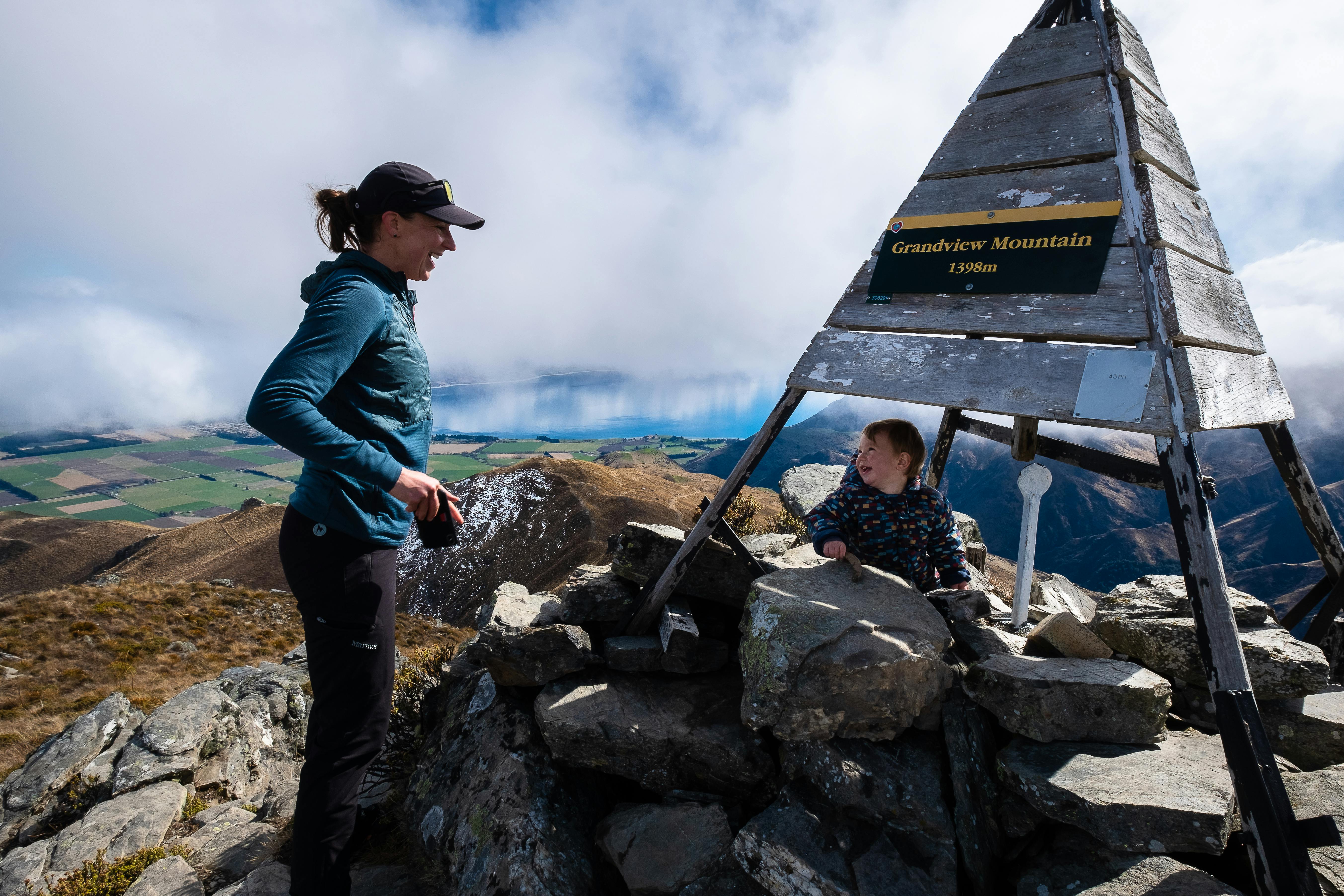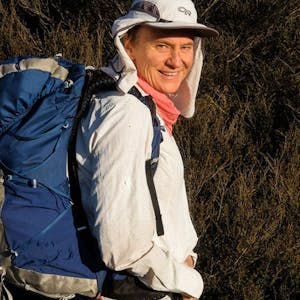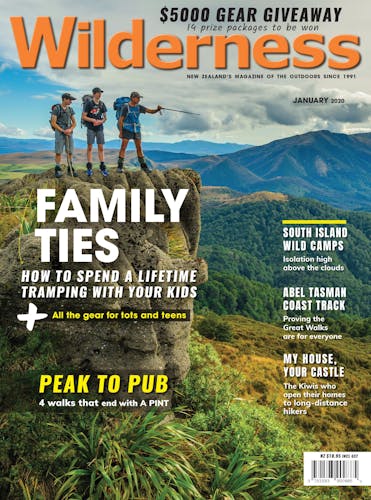Jo Stilwell shares her experience of more than 25 years of tramping with her children and offers advice for parents wanting to get out there with their own kids
The baby years
When my husband David and I started tramping with our first baby, Alice, I was pleasantly surprised at how easy it was.
We had been tramping with David’s daughter Hannah from when she was five and I didn’t want to give up now that I had a newborn. We started with short day walks with Alice in a front pack and as she graduated to a backpack, our day trips grew longer and eventually we went overnight.
Once Alice started on solids, taking snacks and baby food was simple.
If you are parents of a new baby, the main thing is to have confidence in yourself, and give it a try. You’ll need to be more cautious about the weather and be prepared to change plans or cut trips short. And your type of tramping may need to change. Our preference before children had been multi-day, off-track trips but with a baby, this changed to day trips or overnighters.
Start small and easy with your baby and move to other things as your confidence increases. When Alice was nine months old, we had a three-day trip to the Abel Tasman with family friends who also had a baby. Easy tracks and established campsites made this longer trip possible.
We discovered that overnight trips above the bushline were also possible when we embarked on a trip to Hinapouri Tarn, near Lake Angelus in Nelson Lakes National Park when Alice was 10 months old. We lazed amongst the tussocks in the sun, had a beautiful alpine campsite (all to ourselves in those days), and we came away with our hearts and souls replenished.
The first year with a baby confirmed for us that we needn’t give up our outdoor adventures.
If you’re a stay-at-home parent, find people to share your adventures with during the week. I’ve recently met and become very good friends with Maggie Evans, a Lake Hāwea resident, scientist, trail runner, tramper and stay-at-home mum to her now 18-month-old son Huxley. Maggie spends hours each week on the tracks around Lake Hāwea and Wanaka with Huxley either on her back or in the buggy. I’ve accompanied them many times. I can be the helpful extra adult and give Huxley treats while he’s in the backpack or put his hat back on when he rips it off. I can hold him when his mum needs to pee, and I’m always chief coffee maker at lunchtime.
Having friends to support you while you are tramping with a baby makes life much easier.
What we did well
- We went despite my own sleep deprivation – getting ready sometimes felt hard but it was always worth it.
- We changed our goals and expectations – embraced shorter trips and became grateful for well-maintained tracks.
In hindsight, I would have…
- Stayed in more huts – we mostly used tents because I was paranoid about disrupting other trampers. However, I’m now a firm believer that babies belong in huts along with snorers, teenagers who play cards late at night, hunters arriving at midnight or climbers who get up at 4am to catch a freeze.
- Actively sought out other stay-at-home parents to tramp with during the week – for fun, company and fitness.
TIP: What to look for in a child carrier
- Check the recommended age and weight for the child.
- Look for well-padded and fully adjustable straps and easy clip buckles.
- Ideally you can take your baby in and out on your own.
- Small pockets that are accessible while walking are useful, so too are larger spaces for more gear if you want to go overnight.
- Adequate sun/rain/wind protection is essential.
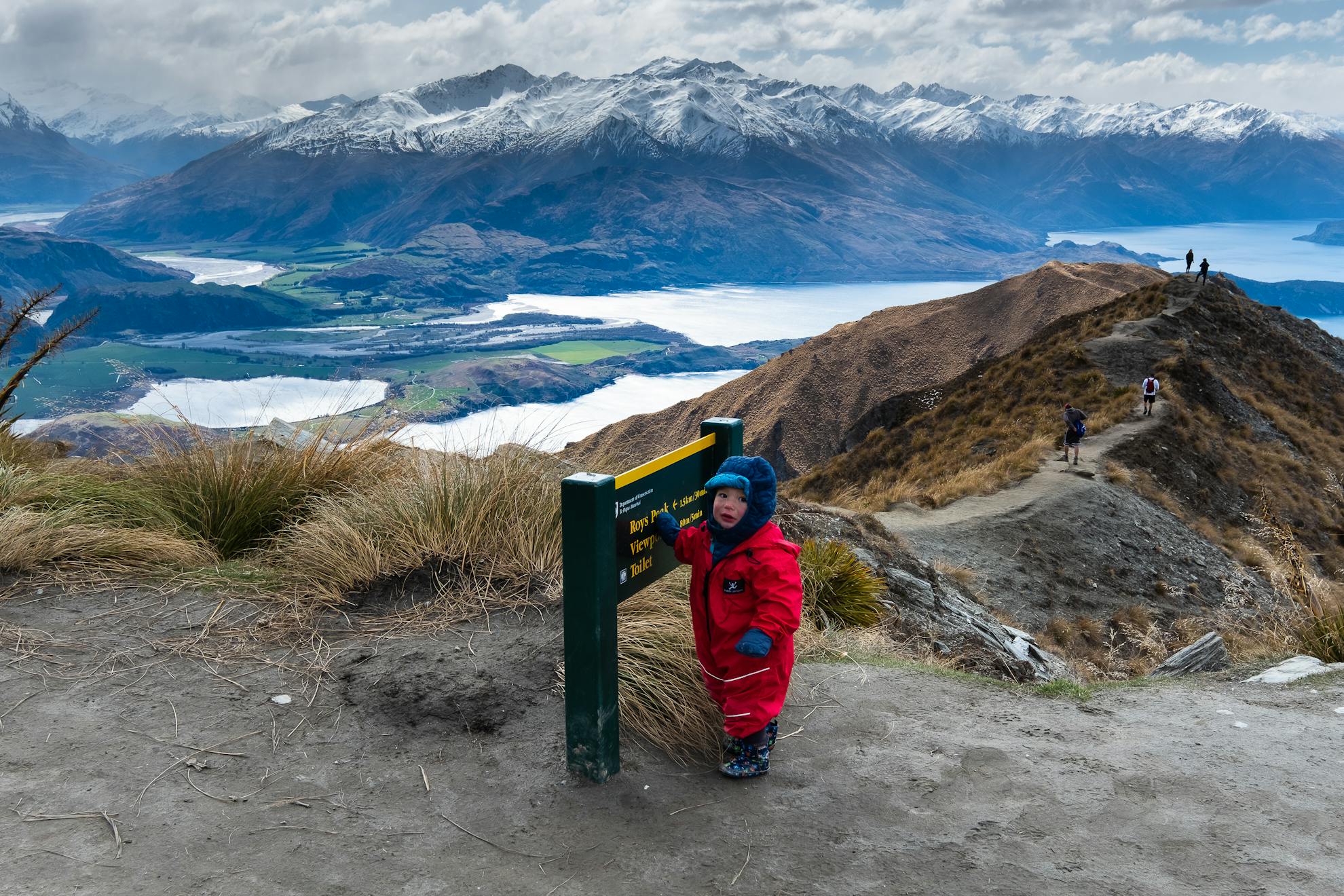
Toddlers and preschoolers
Toddlers are aptly named – they toddle along the track at their own pace in their distinctive bow-legged nappy-wearing style and turn over every rock, pick up every stick and inspect every hole. Encourage it. While you won’t be covering much ground, the more walking you get them doing now, the sooner they will become confident and proficient little trampers.
The toddler years were a big learning curve for us. We could do far less walking with our kids at this age than we could when they were babies.
We needed to develop patience, tolerance and flexibility around our kids’ capabilities and limits, and learn to play in the outdoors in ways that were new to us. We spent a lot of time car-camping at DOC campsites, playing in streams, cooking over an open fire and doing shorter walks.
This was particularly important when our second baby, Mackenzie, was a newborn, Alice was three and Hannah 11-years-old.
But, you’ll be surprised at how far toddlers can walk, especially when bribed with jelly beans. They’ll still require being hoisted over tricky obstacles, carried across rivers and the odd piggy-back at strategic times.
If you want to do multi-day trips, expect heavy packs – having patient adult friends and family who can act as mules will definitely help.
What we did well
- We learnt very quickly that tramping for a young child should be exploratory, experimental and exciting. It’s not about the walking.
- We were flexible with sleeping arrangements – we played musical tents, musical beds and musical sleeping bags – and did whatever was necessary to ensure everyone got sufficient sleep, including going to bed with the kids, even if it was 6.30pm.
In hindsight, I would have…
- Gone out more frequently, even just for short walks on our local hills.
- Made more of an effort to not neglect my own tramping needs.
TIP: Do kids need boots?
Families will differ as to what they think kids need to wear on their feet. One family we know had their three-year-old in boots, another had their kids in sandals and sneakers well into their teens. Our kids had hyper-flexible joints and were always spraining ankles, so we put them in sturdy leather boots from a young age.
A lot of kids will be happy in sneakers, especially on short trips and well-formed tracks. Once venturing further afield, onto snow, scree, tussock tops or slippery river beds, they might benefit from the added confidence that a supportive boot provides, especially once their packs get heavier.
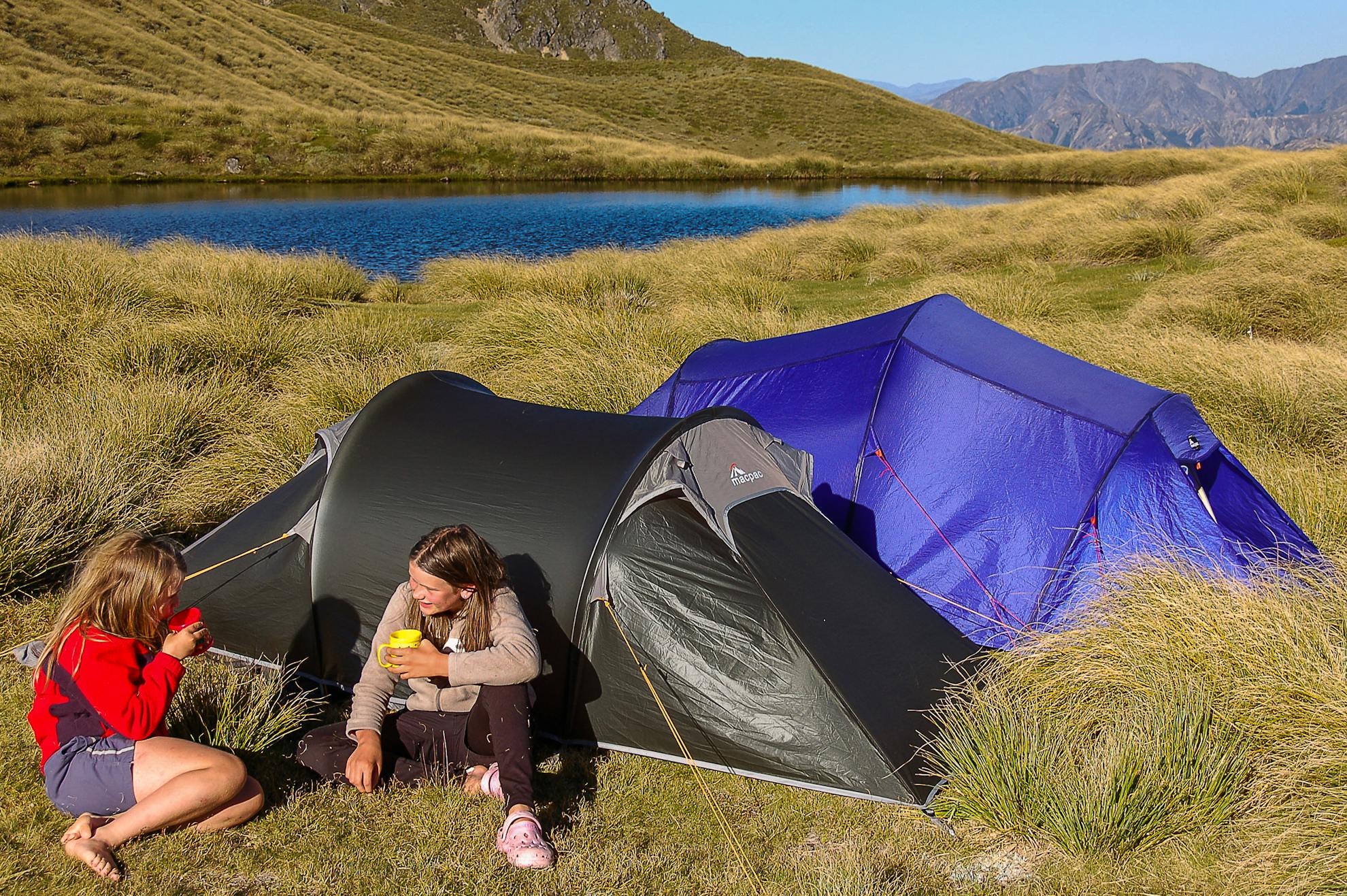
Early school years
By the time our children hit this age (6-11), they were capable walkers and confident on their feet. Longer trips were possible and we introduced them to off-track tramping.
We all enjoyed being above the bushline – climbing up usually involved a long story session, too many lollies, the odd tantrum and lots of rests. They learnt that tramping can be hard work, no amount of whingeing gets them up a hill any easier, and determination and a positive attitude go a long way.
At this age, kids become good company. They are funny and they’ll make you laugh. Jokes tend to centre around bodily functions and toilet talk, which somehow seems more tolerable in the mountains than at home.
This is a good age to introduce compulsory swimming on every tramp between Labour weekend and Easter – it’s a fun challenge to try and uphold.
Also challenging is dealing with the eight-year-old when they sit down and claim mid-tramp that they ‘quit’.
Compassion and patience are important when they are finding things difficult – remember that kids’ mental and physical toughness waxes and wanes, just as yours does.
What we did well
- We told creative stories that sometimes lasted for hours or days.
- We let our kids pick the ingredients for the scroggin (jet-planes, pineapple lumps, coconut chips, banana chips,
as well as the usual nuts, dried fruit and seeds). - We tried to arrive at a campsite with enough time to play – swimming in tarns, climbing trees and exploring the campsite were still more important than the walking.
- We often took more days than we needed for a tramp to make it easier and more enjoyable for the kids.
- With an 11 year age gap between our eldest and youngest, David would go on his own with Hannah to meet her needs.
In hindsight, I would have…
- Kept our kids’ packs lighter for longer. A good friend says you shouldn’t ask kids to carry anything until you are having trouble keeping up with them.
- Looked for lighter gear and dehydrated more meals – I often felt burdened under a crippling pack, especially because we went on long trips.
- Used more huts – the kids loved staying in huts and meeting other trampers, but David and I preferred tents, so we denied them the hut
experiences they might have liked. - Done more Great Walks – under 18s are free. We have only done one Great Walk with our kids and the well-formed tracks, manageable days, and good huts are perfect for this age group.
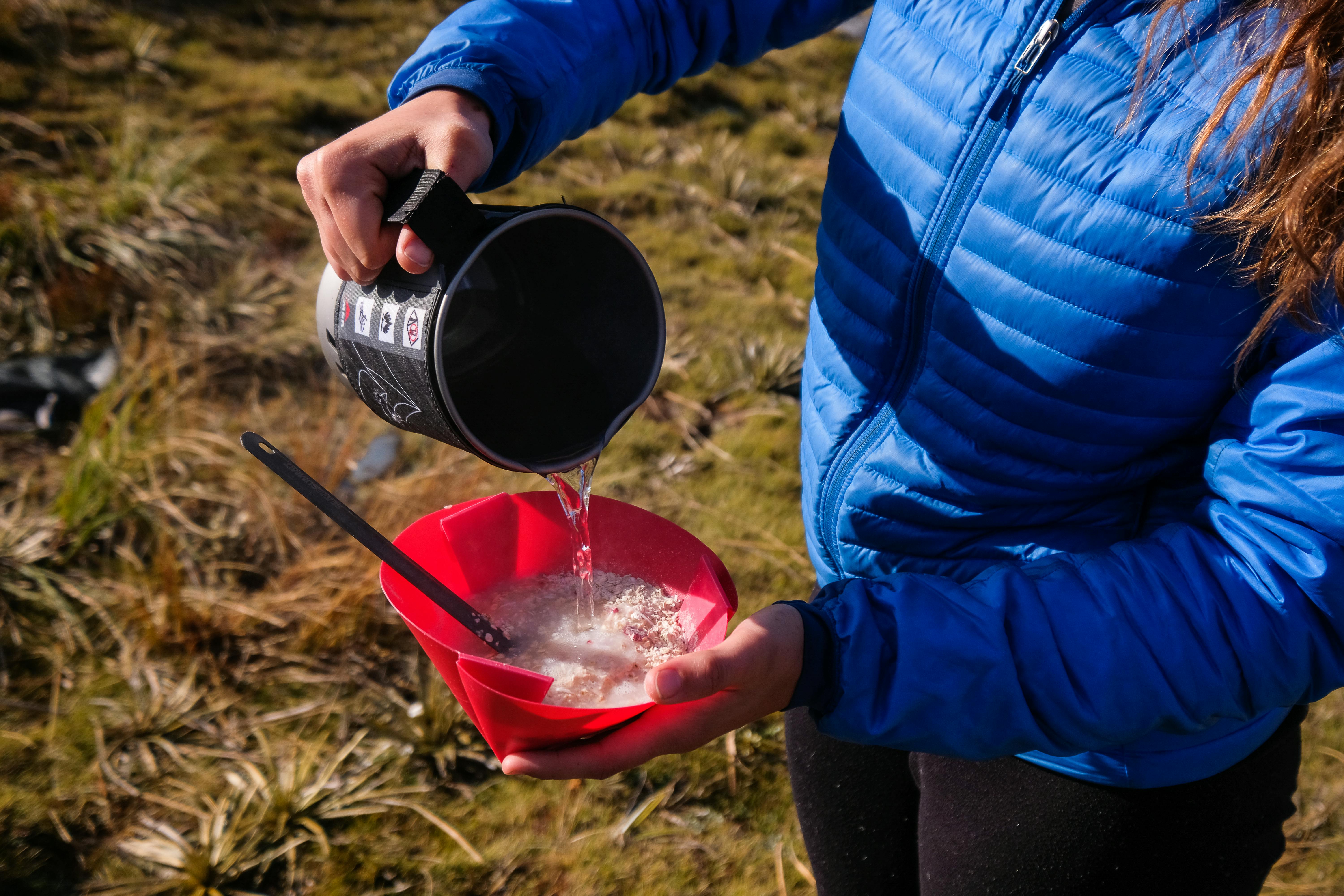
Never wash a grubby porridge pot again. Photo: Jo Stilwell
TIP: Ditch the porridge Pot
Porridge is way easier to make in individual plates (you don’t need pre-bought sachets). Put the oats, milk powder, raisins, almonds and chocolate chips into plates. Add boiling water, stir and wait a few minutes. You can premix the dry ingredients at home to make it easier, and you’ll never have a porridge pot to clean again.
TIP: Toileting tips
- Expect your pack to become heavier as clean nappies are replaced with dirty ones – bury solid waste, then seal nappies in a bag to deal with at home
- Introduce girls to a pee-rag when urinating (no-need for toilet paper, no drips in the knickers and can be dried out in the sun).
- Show kids how to bury toilet waste correctly (70 steps away from water, tracks and campsites, in a hole about 15cm deep and completely covered).
- Be prepared to accompany children to the spider-infested long-drop for many years.
TIP: Make safety a game
An excellent game to play with kids is ‘What would you do if…’.
The idea is to create different scenarios to make them think about safety: what would you do if you came to a flooded river you needed to cross but there was no bridge? Or, what would you do if you became separated from your group, or if the only adult fell and hit their head?
We had quiz questions such as: where is the locator beacon and how do you use it? How do you know whether a river is safe to cross? Name five things from the first aid kit and their uses. This was a fun way to keep the kids occupied on long up-hills and at the same time develop their safety knowledge.
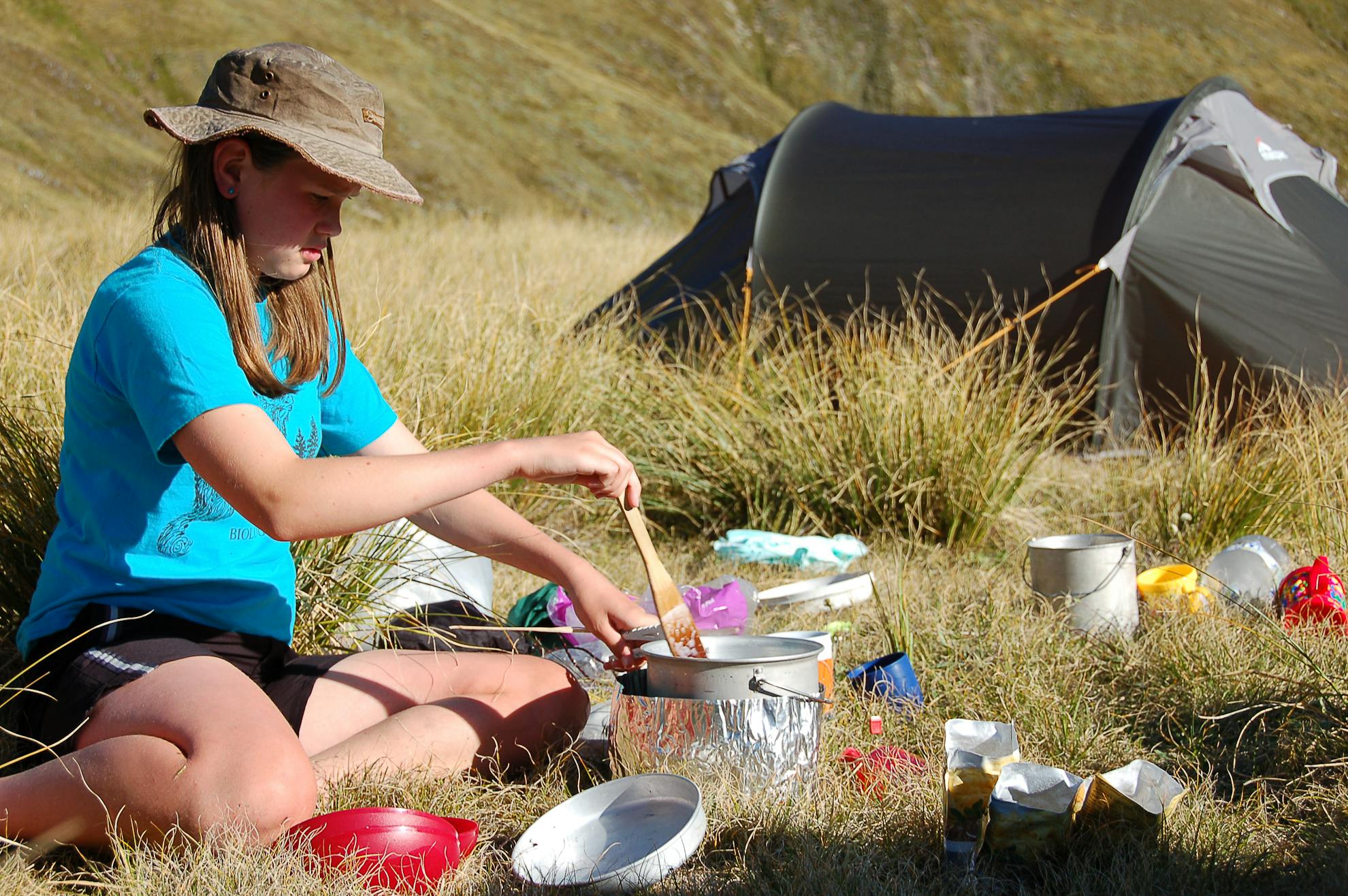
Young teenagers
With young teenagers (11-15-year-olds), we could take them anywhere, provided we kept their packs light. They could carry a decent amount but still not necessarily their share of food and group gear.
They were competent at using the gas cooker and could easily pitch and dismantle the tent. They still hated doing their dishes and as a result often ended up with the remains of last night’s curry in their breakfast.
I was amazed at the things they had picked up by osmosis. We had never specifically taught them how to rock hop up a river but somehow they were competent at it. They knew how to read a map and count contours even though we’d never given them a lesson in map-reading. They knew how to encourage each other, dig deep when needed and, finally, how to apply sunscreen effectively.
Teenagers do have some age-specific behaviours that require special consideration. They can be very self-conscious and may develop a sensitivity to flesh exposure, and skinny dipping during the compulsory swim will not be tolerated any more.
They may also want to take music with them and walk along wearing earphones. They may want to read all night and then sleep in, or they may tell you the night before a week-long tramp that they are now a vegan. The tolerance and patience you built up during their toddler years will come in handy as you celebrate and navigate life with a teenager, both in and out of the hills.
Kids at this age also develop their own lives and interests. They might have busy weekends and family tramping trips might become limited to school holidays. They also might decide they don’t like tramping.
Don’t panic if through their teenage years there’s a gap in the family tramping album – you’ve laid down the foundations for a lifetime love of outdoor adventure and they are bound to return to it at some stage.
What we did well
- We took their friends with us when we could – the change in dynamics meant fewer family arguments and more fun for the kids.
- We introduced them to some amazing places, of which, looking back, they are very appreciative.
- We never forced them to come tramping if they didn’t want to.
In hindsight, I would have…
- Done more one-on-one tramping – kid’s activities in the weekends limited our ability to go away as a family but we could have got out more if only one parent had gone with whichever kid was available.
TIP: Gear
- Think comfort for packs and coats – a good fitting pack is important once kids start carrying a decent weight. A quality coat that keeps them dry will make tramping in the rain more tolerable.
- Take extra clothes for youngsters and always have a change of clothes and a towel waiting in the car.
- Over-trousers are great to throw on to stop sandflies biting.
- Kids love to have their own personal stuff like a pocket knife, headlamp, whistle, or their own cup.
- Taking one book to read out loud to each other (even when they’re older) is a good way to save weight and is also fun.
- Always take a notepad and pen – for writing stories, games and doodling during pit days (the hut book is not designed for this).
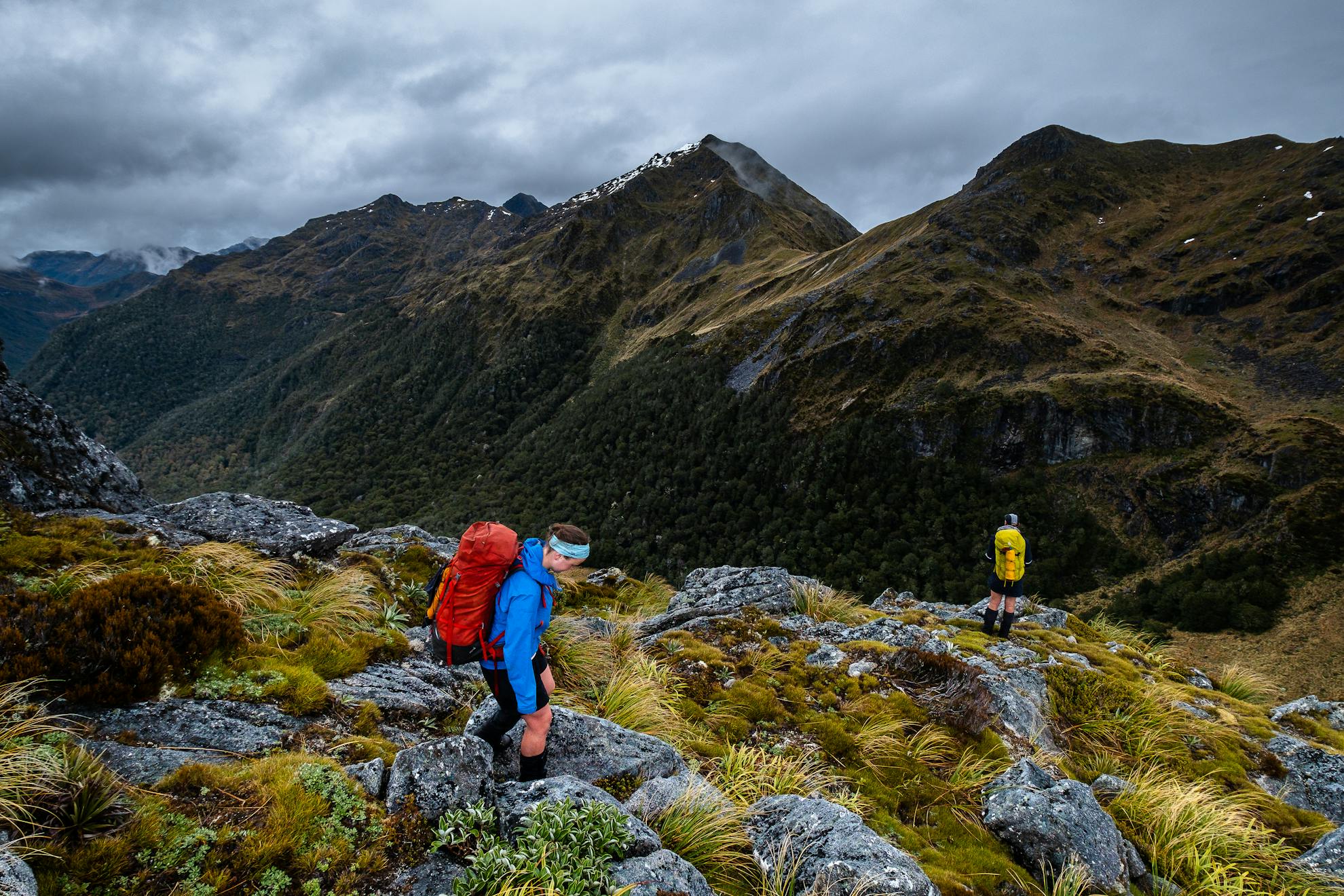
Older teenagers and adults
By the time our kids reached their older teens and young adulthood (16+), they were fully-fledged trampers.
We watched as they went on their first tramps without us, confident that they had the skills to survive on their own. We observed them slowly but surely overtake us in fitness and rejoiced when the weights they carried finally equalled our own. Packing for a tramp felt insanely easy – we no longer needed to check their gear and we didn’t need to negotiate food likes or dislikes.
Kids will always be kids though. They never quite grow out of that teenage fridge-opening behaviour. On one family tramp, we found Hannah and Alice rifling through the food-bag asking why we don’t bring condensed milk anymore – at 26 and 18 they still had fond memories of oozing condensed milk over their porridge.
As teenagers become older, don’t worry if they want to spend New Year’s Eve with their own friends, even if the family Christmas tramp feels under threat. Singing Auld Lang Syne around the campfire with you and going to sleep at 9pm was never going to appeal forever. There are many years of fulfilling adult tramping ahead for you all.
Our adult children show a healthy respect for our experience and wisdom and always seek our opinions and advice when planning their own trips. The respect goes both ways. We marvel at their young knees, their speed and their agility. And they tell us when they think we are being unnecessarily cautious and remind us that we can still do long days in the mountains if we need to.
I’m grateful we have young minds around us to learn new things from, and young bodies to try and keep up with – I’m sure it’s keeping us fitter. We sometimes regret introducing the compulsory family swim – our kids are much braver than us now, and they rarely let us renege.
One of the harder moments of parenting was taking the call from the Rescue Coordination Centre informing us that the PLB registered in our name had been activated. Alice had fallen and dislocated her shoulder and required a helicopter winch to safety. One of the more satisfying times for David was returning a few months later with Alice and her sisters to the place she had fallen to help her face her fears.
We haven’t been away as a complete family unit for many years – one or more of us is usually missing and David and I are spending more time tramping on our own. However, we feel lucky that our adult children still want to go with us when they can. We made mistakes over the years, and there are things I would do differently, but I believe we did a great job of ensuring our kids enjoyed their tramping childhood and they have all grown up with a healthy love and respect for the outdoors.
TIP: Food
- Food needs to be easy and fun – nutrition is important but relax some rules in the hills (the recommended serving size of toasted marshmallows is far too stingy).
- Accommodate a picky eater rather than fight with them.
- Include kids in the menu planning.
- Teach them about rationing treats so some are left for later in the trip.
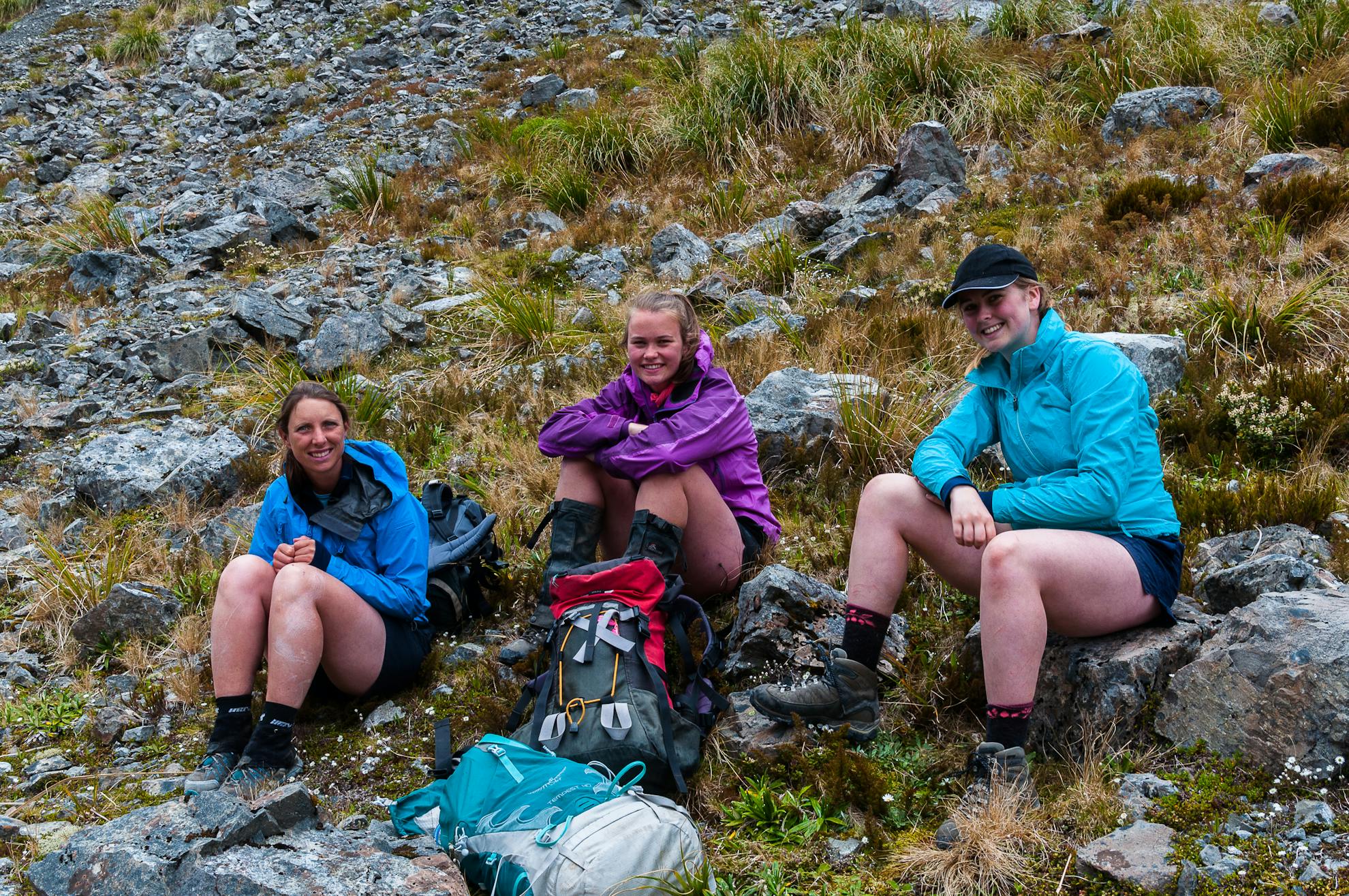
In their own words
Jo and David’s children share what it means to them to have grown up in an outdoors family
Hannah, 31 years
I loved growing up in a tramping family and have so many fond memories from our family adventures. Getting into the mountains is one of my favourite things to do.
I am so grateful for the experience and knowledge which Dad and Jo passed on to me – it’s shown me what is possible on my own two feet and taken me to places that many people don’t realise exist. My favourite tramps have all been ones which I’ve done with Dad and Jo.
As an adult, I feel lucky to share a similar passion with my parents – even though we don’t get out together as often as we might like. They are still my go-to for advice on where to go, how hard the terrain might be and what the weather will do!
Alice, 22 years
I couldn’t be more grateful to have grown up in a family that plays together in the outdoors. It’s the feeling of accomplishment, resilience and sheer joy that are most prominent in my memories of a childhood spent tramping. As an adult, I appreciate the lessons it ingrained in me from an early age.
My other outdoor-inclined friends and I refer to this as ‘outdoor acumen’ – it’s about knowing which stones to jump on a creek crossing, lighting a kick-ass fire, navigating by intuition, or naturally understanding risk assessment – I don’t know if these things are easy to learn as an adult.
I’ve had to keep my cool in a backcountry medical emergency, and although overwhelmed and upset, I was stoked to realise that the years of experience kicked in and I knew exactly what to do.
The importance of play is also huge. I learnt early in life how much of a difference it can make to your wellbeing to stop and slow down.
Mackenzie, 20 years
I wouldn’t change a childhood in the hills for anything. I learnt the importance of perseverance from a young age and that quitting never gets you anywhere, physically and metaphorically.
As a performing arts student, I’ve taken a different direction from tramping but the mountains still feel like a safe place. Whenever life gets hard, all I want to do is go tramping.





